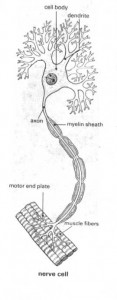Endorphins
Endorphins and how they work
by ally sin
The understanding of how pain is translated into pleasure is extremely complicated. Even reducing it to the simplest of facts doesn’t help. I will try to make sense of what I have learned and present it in a coherent fashion to you. I will be discussing the set of nerves that run from the point of sensation to the brain. The other set of nerves that run in the opposite direction , from the brain to the rest of the body, plays a minimal role here and will be for the most part ignored. A nerve is composed of:
- cell body- manufactures proteins and other substances
- axon- carries nerve pulses from the neuron to the synapse
- dendrite- receives impulses from other neurons
- synapse- space between neurons
The substances produced by the neuron can be placed in 4 categories.
- simple amino acids- vast majority are these
- catecholamines-( mono-amines) epinephrine, dopamine
- indoleamines- (mono-amines) seratonin, melatonin
- acetylcholine- histamine, neuro-peptides (endorphins, substance P)
Now that the basics are done let’s resume how this all comes together. The pain impulse travels to the brain as a result of a pain stimulus. The brain accepts the pain stimulus until a certain level is reached where the brain anticipates damage to the body or tissue.This point varies from person to person and changes through a person’s lifetime. At this point endorphins are released as a defense mechanism.
Okay, what are endorphins? First off endorphins were first discovered in 1975. Since then over twenty different types of endorphins have been identified. The word endorphin is a contraction for “endogenous morphine”. (starting to see why we love it so much?) Endorphins are amino acids manufactured by the nerves. Endorphins are actually a neuropeptide (neuro= from the nerve peptide= amino acid compound). They act as modulators meaning they do not directly stimulate or inhibit on their own but facilitate the action with other neurotransmitters they influence.
Now where were we? Pain has reached intolarence level in the brain….okay. Endorphins are released. Got it. Now the endorphins attach to the neurons within the brain at opiate receptor sites. This causes enkephalins to be released. Now back to the complicated stuff. The enkephilins are created by the break down of endorphins. The amino acid which makes up enkephalins is found in the longer amino acid sequence of the endorphin.
Enkephalins then inhibit “substance P” (yes, that is really what they call it!). Substance P is what allows the pain sensation to be transmitted along the nerve. The enkephalins stop the pain message by suppressing the Substance P.Enkephalins actually bind to the sites that receive Substance P allowing less Substance P to be transmitted thereby decreasing the pain. (half way there!!) Now that the nerves are shut down dopamine can travel along the nerve pathway to the frontal lobe of the brain. Dopamine gives us the feeling of euphoria. During normal activity dopamine is inhibited from traveling along the nerve pathways. Dopamine is manufactured in the part of the brain called the “substantia nigra”, named for it’s dark appearance. Dopamine and norepinephrine are produced by a series of chemical modifications of phenylalanine. Amphtamines mimic dopamine and norepinephrine.
The reaction breaks down rapidly and cannot be sustained for long periods of time. Over time a person may be able to train their body to react faster to release Endorphins more quickly.
Knowing how and why pain becomes pleasure allows us to utilize this natural chain of events for our own delights. It also underscores the importance of warm-up in a “scene”. This allows the sub’s body to start producing endorphins and changing the minds perception of the stimulus.. It also explains why a person can withstand more pain easier in the middle of a “scene” where in the beginning it would have caused extreme negative reaction. This entire series of reactions was intended as a means of survival, of enduring large amounts of pain for short periods of time. But if we turn it into a way of pleasuring ourselves… so what?
